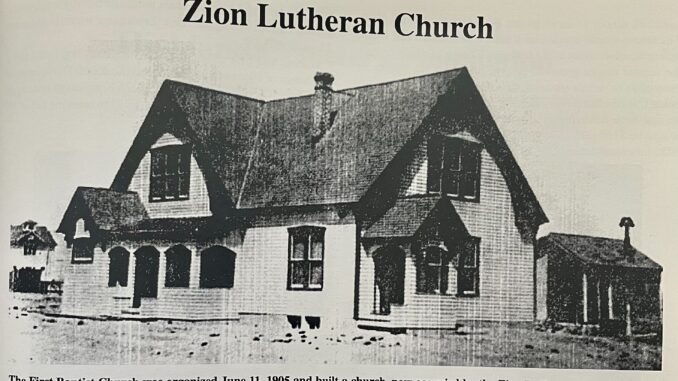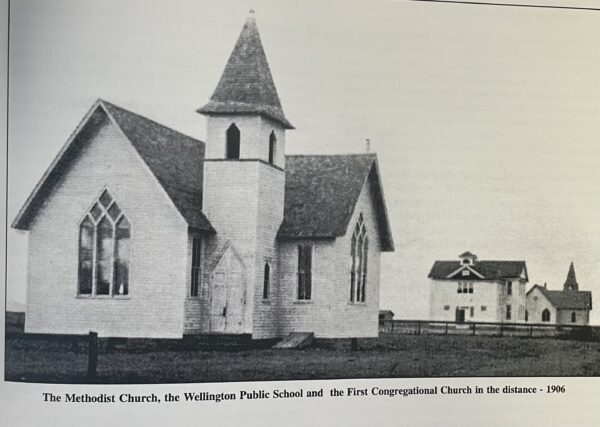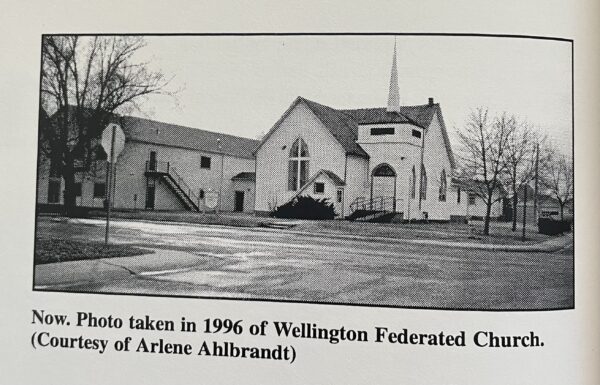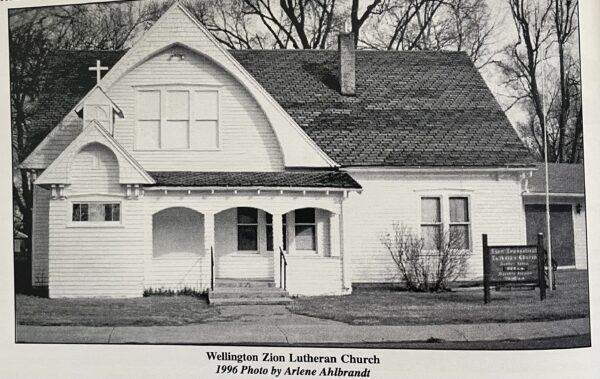
Annie Lindgren
North Forty News
Historic churches are pillars of long-standing significance in supporting and connecting communities. While Wellington churches have been housed in various locations, past and present, we are lucky to have two beautiful historic churches on the north side of downtown Wellington. Here are their stories:
According to the June 29, 1904 edition of Fort Collins Weekly Courier, “the good people of Wellington met at the schoolhouse for the purpose of organizing a church, but as there were members present of too many denominations and each one wanted it his way, there was no definite action taken.” At that time, church services were held at the Wellington School on Third Street.
In September 1904 the Congregationalists met and decided to start a church of their own, along with twenty-one founding members. They raised $3,500; $1,000 from the Congregational Church Building Society of New York, and the rest from local citizens. They broke ground at 8445 Third Street in January 1905. Meanwhile, the Methodists decided to build their church on Third Street, just south of the schoolhouse.

In April 1905 the North Poudre Irrigation Company donated land to the Denver based Congregational Church Association. In May the land and newly built building transferred ownership to the First Congregational Church of Wellington. Pastor Cyril P. Martin led the first service on May 21, 1905. Pastor Martin also happened to be the publisher of the Wellington Sun from 1905 to 1907.
An event held in June 1906 formally dedicated the church. Pastors and members from all of Wellington’s churches, including Congregationalists, Baptists, Methodists, and German Congregationalists were in attendance. They raised enough money to acquire a bell for the building’s tower.
The Methodists and the Congregationalists had their own buildings but by late 1906 they were holding joint monthly services. This went on until 1915 when there was a discussion of consolidating, cutting down on the costs of employing separate ministers. Meanwhile, there were three other churches in Wellington. Of the churches, three were English-speaking and two were German-speaking. The Baptist church leased their building to one of the German congregations and the three English-speaking churches united into a single congregation called the ‘Wellington Federated Church.’ Due to its size, they housed this nondenominational church at the 8445 Third Street location. The Methodist church served as a Sunday school and in 1920 ownership of both churches transferred to the Wellington Federated Church. The Methodist church building was demolished in 1929 after degenerating beyond repair.
In 1941 after being damaged by lighting, they removed the tall steeple over the main entry. The church survived the depression and paid off all its loans in 1942. In April 1946 they sold the church. Other investors and churches made improvements to the building and grounds over the next three decades. In March 1975 North Poudre Irrigation purchased the property from then-owner Poudre School District and in August transferred the property back to the Wellington Federated Church. The following year the church acquired the lot to the south, also owned by North Poudre Irrigation. They made many more changes and constructed the two-story building to the south (which now houses the Boys and Girls Club). In 2004 they renamed the church ‘Wellington Community Church.’ In 2018 they sold their entire facility to the Boys and Girls Club of Larimer County but continued holding services in the church building while working on a new location.

Photo Image captured from ‘History of Wellington, Colorado and The Boxelder Valley, 1864-1996, by Arlene Ahlbrandt.
Nearby, at 8322 N. Second Street, Zion Lutheran Church resides with much history. It started as a Baptist church reportedly built around 1907. In late 1913 the Wellington Sun newspaper shared that “Reverend Philip Schmidt was holding services in the German language at the Baptist church in Wellington.” Schmidt was also preaching at St. Paul’s Lutheran Church in Loveland. For a brief time in 1918 ministers were told to preach only in English due to the war with Germany.
Zion purchased the church building from the American Baptist Home Mission Society in New York for $450 in 1917. In 1928 they purchased the parking lot for $225 plus $20.22 in back taxes. Reverend Frederick Besel, a 60yr old veteran and founder of many churches in Ohio, California, and Colorado, was called to help establish the group in Wellington. He previously founded Zion in Loveland and Johnstown. The birth of the Zion congregation happened in March of 1914.
There is a long and interesting history of pastors, prominent in the area and church, that were a part of the early days of Zion. Reverend Fred Hefner enjoyed a long ministry, beginning in 1919. He had graduated from Wartburg Seminary in Iowa and brought the Iowa Lutheran Synod to town. He defended the viability of his mission during the 1930’s discussions regarding financial struggles when the Iowa Synod strongly recommended that Zion find a nearby congregation to share a pastor. Reverend Hefner moved to Nebraska in 1933 and the church entered a dual parish arrangement with another church in Greeley for a short while. The Iowa Synod merged with other synods to form the American Lutheran Church. Zion decided to change affiliation to the Missouri Synod in May 1938. There was a lot of changeover in Reverends and expansions of the church, including housing a Lutheran elementary school and acquiring the house across the street, originally the Methodist parsonage.
Back in 1906 Reverend Paul Fritsche, a Lutheran pastor at Trinity in Greeley, held meetings in Wellington at a farm west of town. He would take the train to Fort Collins, have services there, ride his bike to Wellington for evening services and head back to Greeley for the week. From 1951 to 1964 Reverend Fritsche rejoined the Wellington church community after returning early from war. He traveled by bus from his daughter’s home in Denver to spend the weekends in Wellington. He would room with locals until the church set up an apartment within the church. The restroom was in the basement, down a twisting and low-header stairway still in existence.
More changeover left the church struggling with declining membership and there was a discussion of closing the church. They requested help from the Colorado District and were linked with Faith Lutheran in Johnstown. In 1973 Reverend James Laatsch served as missionary-at-large to the rural areas of East Larimer and west Weld County. He resigned in 1977 and returned to Wisconsin. Reverend Albert Schroeder served from 1978 to 1992 and during that time they built the parish hall on the south end of the church. They planned a 1983 Easter breakfast in the newly constructed space. However, it had snowed heavily on the still exposed subfloor and plans had to be changed. They completed construction in September.
Then a Pastor, whose approach was not agreeable to members, caused a decline in membership. The music ministry had a conflict with two organists who didn’t get along and struggled to operate the old pump organ and learn new songs. A school was established but could only operate for one year due to a lack of funds. Due to space restrictions the school opening caused the Food Bank to move to the Wellington Community Church. More changeover and time of financial struggle ensued. Finally, in 1998 Pastor Frank Winter and his wife Carla stepped in. They purchased a new electronic organ and Carla led as organist and musical director. Membership started to increase but Pastor Winter wasn’t full-time. They brought in Mark Gabbert as director of Christian Education to get youth activities going.
The church was ready for a full-time pastor. Many congregants wanted Mark Gabbert to be ordained in the Missouri Synod to become pastor but this was not an option. Zion then discovered Lutheran Churches in Mission for Christ and a breakaway group from the ELCA formed in 2001. The congregation voted to join this synod and was accepted by LCMC in 2009 releasing them from the Missouri Synod. Mark was ordained and became pastor of Zion. The church was finally debt-free and primed for growth. They hired a new music director, Clinton Ellerbe, in April 2007. The Zion Choir, initiated in the Fall of 2008, now has much musical talent from members of all ages.
The church has grown in the past decade. A community garden started in 2012 shares food with the Food Bank. There are a variety of programs and annual events. Renovations refreshed the spaces, both inside and out. A separate nonprofit, Grace Village, was established to help address issues in the community, like the needs of the Wellington Food Bank. There are plans to build a facility on Zion’s south lot which will serve as the Community Services Center and be the new home for the Wellington Food and Clothing Pantry coming in 2022.

These historical buildings embrace much life and community happening within their walls. There are, of course, many more stories in the tales of these two Wellington Churches. This author always ends up with more questions than answers when diving into the history of these local relics.
The historical information about the Wellington Community Church came from a historical survey completed by Tatanka Historical Associates in a 2018 survey conducted through the Wellington Main Streets Program, found at wellingtonmainstreet.org/
Support Northern Colorado Journalism
Show your support for North Forty News by helping us produce more content. It's a kind and simple gesture that will help us continue to bring more content to you.
BONUS - Donors get a link in their receipt to sign up for our once-per-week instant text messaging alert. Get your e-copy of North Forty News the moment it is released!
Click to Donate
